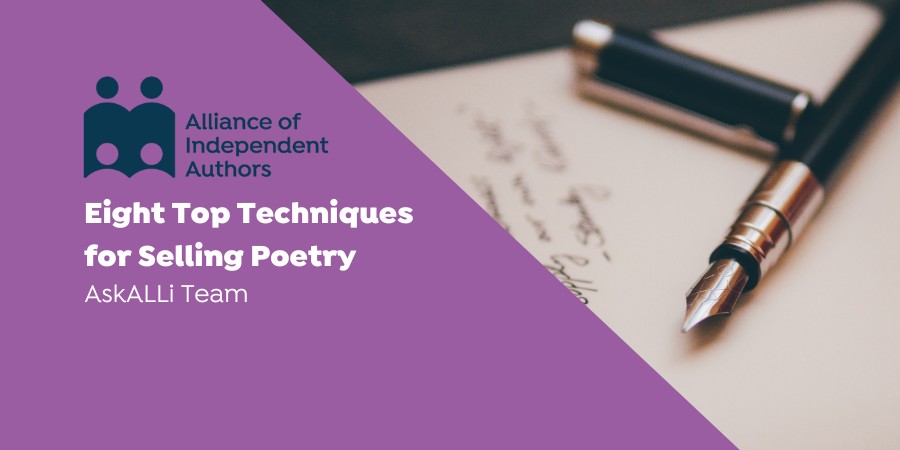
Photo by Álvaro Serrano on Unsplash
How can you ensure your poetry is getting the attention it deserves? This week the Alliance of Independent Authors (ALLi) blog shares eight top techniques for reaching your readers and selling poetry.
Take your pick: from submitting to literary magazines and competitions, to posting on social media and participating in podcasts. Each technique will raise your profile, speak to your potential readers, and ultimately increase your sales.
It's all in the planning…
Before we get started on the different routes you can take to reach your readers, it’s worth remembering the key planning concepts we return to again and again to help you prioritise your marketing and promotional activity, and make the right choices for your work.
Consider why you write
This may sound like a simple question, but being clear about why you are writing and what you see as success will help you hit your goals and reach the right readers.
Are you looking for wide readership, or are you more focused on a small, dedicated following? Are you looking to make a career from your poetry, or are you happy to view it as a side project? Is success being an award winner, gaining a ‘best seller’ badge, or simply receiving positive feedback from your readers? All of this can help you identify which next steps to take.
Identify your poetry niche
Just as with fiction or non-fiction, most poetry fans will have a specific taste in poetry. Identifying where your work sits within these tastes will help you find the right readers for your work.
Take some time to list the themes, techniques or emotions your work often touches upon to build a picture of what you offer, and subsequently what your readers will be interested in. Just a few questions to kick off could be:
- Is your work empowering or spiritual?
- Do you reflect reality in your work?
- Are you using imagery, photos or drawings?
- Do you have specific influences?
- Is your poetry narrative, lyrical or dramatic?
Understand your readers
Based on the work you have done to identify what you want to achieve and the niche in which your work best fits, you can take the next step of considering the readers themselves:
- Who they are? (consider demographics such as age or gender)
- Where they are?
- Where do they buy their books?
- Which influencers do they listen to?
- What do they want from the poetry they enjoy?
This understanding of who your readers are will help you decide all sorts of sales decisions; where to market your books, how to distribute them, and how to describe what you offer.

Photo by Álvaro Serrano on Unsplash
Revisiting traditional techniques for finding poetry readers
Nowadays, when considering marketing and promotion to sell any product, social media can be the first channel that comes to mind. But for poetry, this isn’t necessarily the case.
Let’s look at how to utilize some of the more ‘traditional' channels first.
Literary Magazines
One of the most important elements of literary magazine production is that most of these publications are run by poetry lovers. They are often personal, passion projects and each one has its own distinct character and focus. Some magazines have continued in print, others have moved to digital. But they all have one thing in common; they are on the lookout for great work, and are therefore ideal for raising a poet's profile.
Of course, there are only so many slots, and competition is high. You may need to submit several times before you get lucky. To raise your chances, ensure you take the time to understand the criteria and submissions process before sharing your work with busy magazine teams.
Our friends at Reedsy have produced this great guide to the best literary magazines for indie authors in 2023, with 100+ magazines listed by format (print or online), traffic, and category: Reedsy Literary Magazines Guide.
And Trish Hopkinson, who was a key part of the ALLi poetry podcast for a long time, is still going strong writing great poetry and helping other poets at: TrishHopkinson.com. Trish specialises in news about paying outlets for poetry.

Orna Ross, ALLi Director
Three top literary magazines from ALLi Director, Orna Ross
There are too many literary magazines in the world for us to keep track of them all, so we called in our director, Orna Ross, who also happens to be a bestselling and award-winning poet, to tell us about just three of her indie favorites.
Of course I must begin in Ireland and my favorite Irish review is The Stinging Fly. I remember it being set up in 1997 with a mission of “seeking out, publishing and promoting the very best new Irish and international writing” and it has fulfilled its mission. The magazine has ample room for poetry and includes fiction too. Novelist Sally Rooney is currently a contributing editor. There's also The Stinging Fly podcast to check out.
Acumen, one of the longest-running literary magazines in the world, is based in the UK. Its founder, Patricia Oxley started the poetry review n 1985 armed with only an electric typewriter, and without a single subscriber or poem, just an idea, a poet for a husband, and her trusty typewriter. It's now one of the UK's leading literary journals, and Oxley was awarded an MBE for her contribution to poetry. Their anthology is available on Amazon.
The Lifted Brow was founded in Melbourne in 2007 and is currently restructuring. Its focus is on finding publishing and championing work “from artistic and demographic margins” from Australia and the rest of the world.
My go to place to keep up with submission opportunities is the literary magazines list published by US magazine, Poets and Writers (see competitions below also). Their mission is to “foster the professional development of poets and writers, to promote communication throughout the literary community, and to help create an environment in which literature can be appreciated by the widest possible public”. One way they do that is with their wide-ranging list that includes everything you need to find a lit mag that suits you, including their editorial policies, submission guidelines, contact information and a handy searchable database. They also have a “publicity incubator“.
Poetry Competitions
Winning, or even being shortlisted, for a competition can raise your profile not only in the industry, but with potential readers. A competition win can mean the stamp of approval for some, and can bring new poetry fans to your work.
Beyond reaching new readers, one of the other great things about poetry competitions is enforcing a writing deadline on participants.
For many writers, having the pressure of a date to complete can motivate speedier writing and increase your creative delivery overall. It can also create boundaries for your work that can inspire ideas you may not have explored otherwise, for example, by giving a set of rules on length or a theme that you must follow to enter.
And let’s not forget the financial positives of winning competitions. Some have prizes in the four and even five figures, which can be a great one-off boost for ensuring you can spend more time writing.
One question ALLi is often asked, is whether you can submit a poem to a competition that has in any way been shared before (for example, on your own social channels). In a previous blog, poet, and co-host of the Self-Publishing Poetry Salon, Dalma Szentpály shared this insight:
When you put something online, yes, it's out there but, such is the rate at which all of this moves, that the number of people who've actually seen that poem is not going to be a huge number. So, I would recommend, if you're going to enter it into a competition and in the rules and regs it says it's not supposed to have appeared before, I’d take it down. Take it down and then submit it. So, you're not breaking the rules and regulations, but really, unless you've got a huge following on there, avidly waiting for your next poem to come out I wouldn't worry about it because there's no real clash there.
How do I find poetry competitions?
There are lots of poetry competitions out there and you’ll want to pick one that fits your work best, so do your research.
The literary magazine, Poets & Writers, have a database of competitions and funding opportunities. You can filter the contents or the database by genre, so you can select poetry, whether you need to pay something to enter the competition or not, and the deadline: Poetry Competitions Database.
Libraries and Subscription Services
There is a strong crossover between core library users, 18 to 35-year-old women, and poetry readers. Many library visitors are prolific readers, and can therefore become committed fans. Discovering your work through a library may also lead to further sales through word of mouth between your borrower and their networks.
Similarly, reader subscription services, where avid readers pay a subscription to access a range of ‘free’ books on a smart device, have large groups of readers with some looking for regular access to new poetry. These include services such as Scribd, Bookmate, OverDrive, and Bibliotheca.
 If libraries become part of your strategy, take a look at the ALLi book, ‘Your books in Libraries WorldWide'. ALLi books are available for purchase in multiple formats on our bookstore. Members enjoy free access to the ebook and many more.
If libraries become part of your strategy, take a look at the ALLi book, ‘Your books in Libraries WorldWide'. ALLi books are available for purchase in multiple formats on our bookstore. Members enjoy free access to the ebook and many more.
Self-Publishing Poetry (ebook & print)
We can't talk about selling poetry without touching on self-publishing itself. Poetry has a rich history of indie publishing, from pamphlets to ebooks. But where should you sell your poetry to your readers?
Selling directly through your own website can be a great way to host rich information about your work in one hub which you can control and update regularly. This works if you are advertising on platforms such as Facebook or through channels such as BookBub. You can grab a reader’s attention with your ad or message, and direct them straight through to your own website to find all they need to make a purchase.
And you don't need to always publish a full collection. Many poets use the ‘chapbook' model, which harks back to literary pamphlets. These means collecting a smaller selection of poems in a booklet of usually under 40 pages long, and often related to one theme. They can be relatively inexpensive to print and are suitable for local events, literary festivals, markets and direct selling. They offer readers an inexpensive way to take a risk on your work and receive a sample of what you offer.
However, if you have an interest in charting, or are looking to reach audiences reading other poets who sell through Amazon, you may also want to host some or all of your content here too. Amazon’s algorithms can connect you to readers of poetry similar to your own and build your fanbase.
Either way, ensure you offer the opportunity for readers who do make a purchase to stay connected to you by collecting email addresses for a newsletter or similar with a prompt at the point of sale or at the end of your publication. This will build a central core of people who love your work and who you can return to every time you have a new release or a message to share.
To find out more about setting up a newsletter, check out the ALLi blogpost: Reaching Readers with Author Newsletters.
Self-Publishing Poetry (audio)
In recent years, the trend for people wanting to hear poets reading their work has grown. This may reflect the enduring interest in spoken word and events such as poetry slams. This performative nature of some poetry can make it ideal for audio, another selling route for your work.
But how is it best to record your poetry and is it different to other genres? Dalma Szentpály suggests sticking with the audiobook format:
I would suggest doing it as an audiobook and having a separate eBook. Both from the production side and from the distribution side, it's easier to start it that way.
You can find out more about producing audio books with ALLi's Ultimate Guide to Self-Publishing Audio Books. This includes contributions from the team at Soundwise, which is a useful example of a website where authors can host and distribute audiobooks and podcasts too.

Photo by Myriam Jessier on Unsplash
And now for the not so ‘traditional'…
Moving away from the traditional routes for sharing your poetry, let’s take a look at the digital and emerging channels you could consider.
Social Media
Social media doesn't always directly sell your work, but it can be an opportunity to share more of yourself as a poet and artist with your audience. It’s a way to build your brand and create a longer-lasting relationship with your readers.
Unlike submitting to a magazine or competition, social media can offer you real-time responses to your work. Channels such as Tumblr, Instagram, TikTok, Facebook or X (Twitter) can connect you to large groups of like-minded readers, and the feedback and response you will get when posting your work can build and improve your own writing skills too.
It's also a place that you can share work that you don’t feel is polished enough or appropriate for your more formal publishing channels. The expectation on these informal channels is different to a printed publication, and work that is a little rough and ready can go down well with audiences looking for authentic content quickly released.
If you aren’t keen on sharing full poems for free on your social channels, you could still use them for teasers and tasters from your work, then link on to your website or sales page for more.
If you're new to social media, see if your own favourites are active on any of the main channels. What are they posting, and how does it works for them? This can be great for inspiration. You can search for #poetry, #poetsofinstragram (or another platform), or similar on any social channel to see who is being followed and what's trending (i.e. being talked about). One poet who is always worth a look is: @atticuspoetry. With over 1.7million follows, they also use their profile as a shop front for their work.
Social media does take time, and consistency, to build an audience. You should generally aim to post every day, ideally more than once a day if you can. So prioritising one or two channels, and having a plan across the month or week can help keep on top of the activity.
Some starter ideas for what you can post on social channels include:
- Creating and sharing striking images with one powerful or distinctive line of your work (there are many apps available that can quickly create images that are social media ready)
- Sneak peaks from behind the scenes showcasing you at work
- Images of what has inspired your writing today
- Short audio or video of you reading your own work
- Your responses to other poets and poetry, to connect to the wider community
- Sharing ideas for feedback from your audience
One watch out – although immediate responses can be great for learning, it can also be challenging if some of your followers or others out there have negative messages to share back. You may need to have a thick skin and try to focus on the positives as your presence grows.
You can find out more about using social media for marketing by listening to this ALLi Podcast with Orna Ross and Joanna Penn, exploring Social Media For Authors.
Poetry Podcasts
There are still minimal podcasts out there focused on self-published poets, but they are growing, so it’s worth keeping on top of what’s on offer. Podcasts can be great for poets, both as listeners staying connected to the poetry community, and for raising your own profile by offering your voice to the broadcast.
If you feel you have something to share with a podcast, either your own poetry, or tips and tricks for writers or readers, it’s worth getting in touch with a podcast team to see if you can get involved and raise your profile by being a contributor.
You should be able to include a plug for your work in the recording and potentially in any transcripts or posts placed afterwards too. Always ask to see what the podcast will allow.
The website, podcastreview.org, lists all kinds of podcasts, and includes a good selection of those focused on poetry, such as Poem Talk, and Poetry off the Shelf. Take a look through to see what would suit your work and interests.
Patreon for Poetry
Patreon is a membership platform that allows readers to pledge money to support your poetry. It is growing every day as an alternative income method for creators and can be a great platform for poets to nurture readers.
A form of crowdfunding, it differs from other platforms in being based around ongoing effort and smaller, consistent output. If Kickstarter and Indiegogo are sprints (best for books and bigger projects), Patreon is a marathon (best for poems and smaller projects that are ongoing).
Unlike other crowdfunding, Patreon campaigns don’t stop. Your primary commitment is the need to post your promised content to your promised schedule. So, as you set up, be aware of your creative and organisational capacity. Don’t over promise.
Start small and build, or risk turning something that can be extremely rewarding into a chore.
Before starting a Patreon campaign, take a look at graphtreon.com/patreon-creators/writing which shows the top-earning creators on Patreon. You can get great ideas from seeing who's successful and observing how they do things.
Finally, even if you’re posting great poems, count on losing patrons every month. Patrons come and go as people’s finances and interests change. Sometimes they are only supporting you for a while, and that’s fine. Keep writing and promoting your poems and your readers will build over time. Getting together with some other poets to create your Patron page is a great way to make everything easier.
Are their other options to Patreon for ongoing patronage?
Orna Ross, ALLi Director, has recently made a change to her patronage plan that may suit other poets. Here's why she made the move:
To build a Patreon following, you need a marketing infrastructure in place. Contrary to what many beginners assume, Patreon does not market your work for you on the platform. For that reason, and some others, I recently moved my poetry patronage from Patreon to my own website. You can see how that runs on OrnaRoss.com/become-a-patron
Wherever you locate your patronage subscription model, and whatever platform you use, it’s a great model for indie authors to use in conjunction with regular marketing activity. The strategy shifts focus from directing readers to the point of sale, to building a long-term, ongoing customer relationship. And this approach is where the freedom Indies enjoy, particularly in terms of business decisions, can give you an advantage over those with a third-party publisher.
In conclusion…
From the traditional to the digital, there are lots of ways to reach out to your readers and build your profile, all with the ultimate goal of increasing your poetry sales.
But, there is no ‘right' way. Your approach needs to fit your time and budget, and target the audience in your niche, to be sustainable and successful. One way to build your plan is to prioritise a selection of these techniques to test out, keep an eye on the engagement and sales impact from each one, and find out what combination works for you. Based on what works, you will then have an ongoing approach to implement that gets the results you need. And remember to keep an eye out for emerging trends to test as you progress.
Find out more
 For more on marketing poetry, take a look at the ALLi Marketing Poetry on a Budget post.
For more on marketing poetry, take a look at the ALLi Marketing Poetry on a Budget post.
And for more information across a range of poetry topics, Orna and Dalma have produced a series of podcasts to support your self-publishing poetry journey. You can explore them all in ALLi's Podcast Archive.




